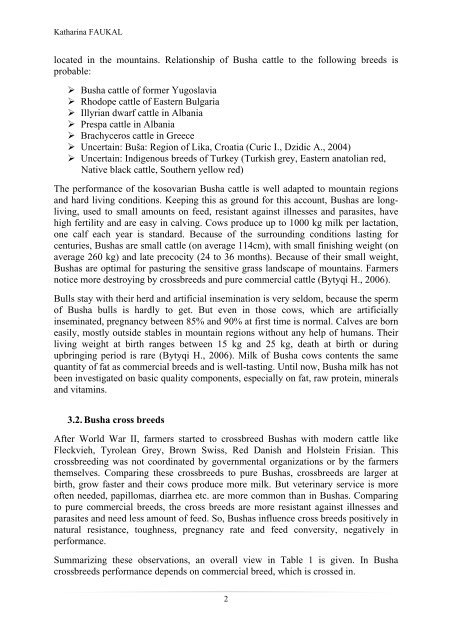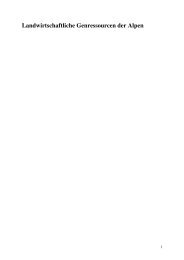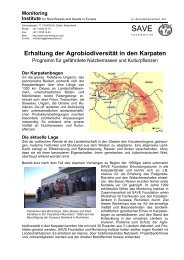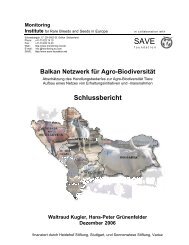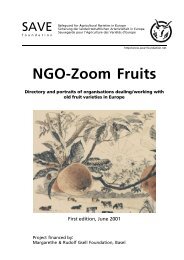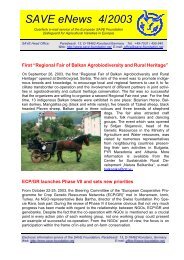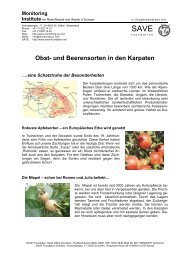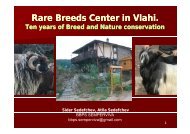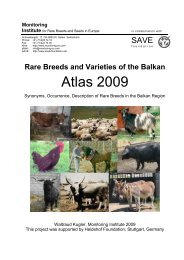The Busha cattle – a breed originated in middle ... - SAVE Foundation
The Busha cattle – a breed originated in middle ... - SAVE Foundation
The Busha cattle – a breed originated in middle ... - SAVE Foundation
Create successful ePaper yourself
Turn your PDF publications into a flip-book with our unique Google optimized e-Paper software.
Kathar<strong>in</strong>a FAUKAL<br />
located <strong>in</strong> the mounta<strong>in</strong>s. Relationship of <strong>Busha</strong> <strong>cattle</strong> to the follow<strong>in</strong>g <strong>breed</strong>s is<br />
probable:<br />
<strong>Busha</strong> <strong>cattle</strong> of former Yugoslavia<br />
Rhodope <strong>cattle</strong> of Eastern Bulgaria<br />
Illyrian dwarf <strong>cattle</strong> <strong>in</strong> Albania<br />
Prespa <strong>cattle</strong> <strong>in</strong> Albania<br />
Brachyceros <strong>cattle</strong> <strong>in</strong> Greece<br />
Uncerta<strong>in</strong>: Buša: Region of Lika, Croatia (Curic I., Dzidic A., 2004)<br />
Uncerta<strong>in</strong>: Indigenous <strong>breed</strong>s of Turkey (Turkish grey, Eastern anatolian red,<br />
Native black <strong>cattle</strong>, Southern yellow red)<br />
<strong>The</strong> performance of the kosovarian <strong>Busha</strong> <strong>cattle</strong> is well adapted to mounta<strong>in</strong> regions<br />
and hard liv<strong>in</strong>g conditions. Keep<strong>in</strong>g this as ground for this account, <strong>Busha</strong>s are longliv<strong>in</strong>g,<br />
used to small amounts on feed, resistant aga<strong>in</strong>st illnesses and parasites, have<br />
high fertility and are easy <strong>in</strong> calv<strong>in</strong>g. Cows produce up to 1000 kg milk per lactation,<br />
one calf each year is standard. Because of the surround<strong>in</strong>g conditions last<strong>in</strong>g for<br />
centuries, <strong>Busha</strong>s are small <strong>cattle</strong> (on average 114cm), with small f<strong>in</strong>ish<strong>in</strong>g weight (on<br />
average 260 kg) and late precocity (24 to 36 months). Because of their small weight,<br />
<strong>Busha</strong>s are optimal for pastur<strong>in</strong>g the sensitive grass landscape of mounta<strong>in</strong>s. Farmers<br />
notice more destroy<strong>in</strong>g by cross<strong>breed</strong>s and pure commercial <strong>cattle</strong> (Bytyqi H., 2006).<br />
Bulls stay with their herd and artificial <strong>in</strong>sem<strong>in</strong>ation is very seldom, because the sperm<br />
of <strong>Busha</strong> bulls is hardly to get. But even <strong>in</strong> those cows, which are artificially<br />
<strong>in</strong>sem<strong>in</strong>ated, pregnancy between 85% and 90% at first time is normal. Calves are born<br />
easily, mostly outside stables <strong>in</strong> mounta<strong>in</strong> regions without any help of humans. <strong>The</strong>ir<br />
liv<strong>in</strong>g weight at birth ranges between 15 kg and 25 kg, death at birth or dur<strong>in</strong>g<br />
upbr<strong>in</strong>g<strong>in</strong>g period is rare (Bytyqi H., 2006). Milk of <strong>Busha</strong> cows contents the same<br />
quantity of fat as commercial <strong>breed</strong>s and is well-tast<strong>in</strong>g. Until now, <strong>Busha</strong> milk has not<br />
been <strong>in</strong>vestigated on basic quality components, especially on fat, raw prote<strong>in</strong>, m<strong>in</strong>erals<br />
and vitam<strong>in</strong>s.<br />
3.2. <strong>Busha</strong> cross <strong>breed</strong>s<br />
After World War II, farmers started to cross<strong>breed</strong> <strong>Busha</strong>s with modern <strong>cattle</strong> like<br />
Fleckvieh, Tyrolean Grey, Brown Swiss, Red Danish and Holste<strong>in</strong> Frisian. This<br />
cross<strong>breed</strong><strong>in</strong>g was not coord<strong>in</strong>ated by governmental organizations or by the farmers<br />
themselves. Compar<strong>in</strong>g these cross<strong>breed</strong>s to pure <strong>Busha</strong>s, cross<strong>breed</strong>s are larger at<br />
birth, grow faster and their cows produce more milk. But veter<strong>in</strong>ary service is more<br />
often needed, papillomas, diarrhea etc. are more common than <strong>in</strong> <strong>Busha</strong>s. Compar<strong>in</strong>g<br />
to pure commercial <strong>breed</strong>s, the cross <strong>breed</strong>s are more resistant aga<strong>in</strong>st illnesses and<br />
parasites and need less amount of feed. So, <strong>Busha</strong>s <strong>in</strong>fluence cross <strong>breed</strong>s positively <strong>in</strong><br />
natural resistance, toughness, pregnancy rate and feed conversity, negatively <strong>in</strong><br />
performance.<br />
Summariz<strong>in</strong>g these observations, an overall view <strong>in</strong> Table 1 is given. In <strong>Busha</strong><br />
cross<strong>breed</strong>s performance depends on commercial <strong>breed</strong>, which is crossed <strong>in</strong>.<br />
2


